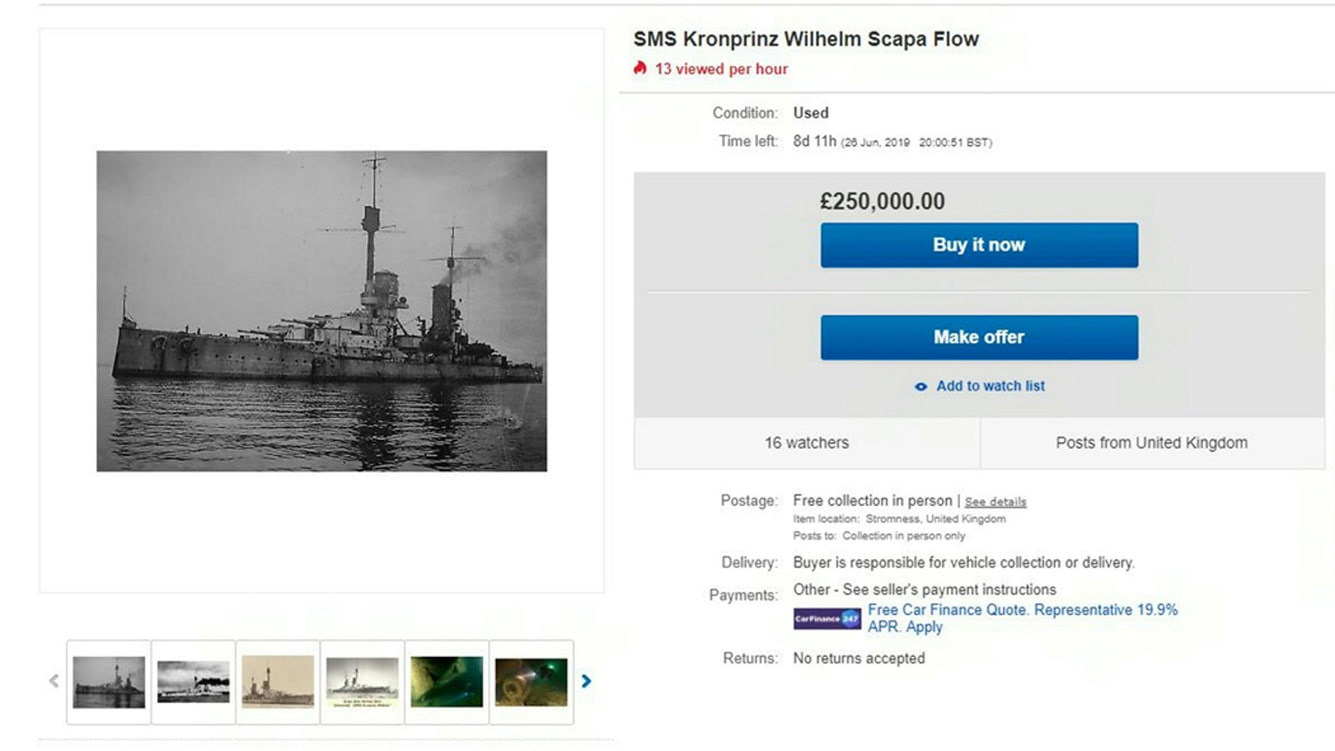Using the internet, people can sell anything.
For example, back in 2006, the e-commerce platform eBay had a 405-foot megayacht on sale. It was priced at $168 million, sold to a Russian billionaire Roman Abramovich, with the transaction completed with Florida Fort Lauderdale’s 4Yacht brokerage firm.
This time, someone is selling four World War I battleships.
Three of the four vessels, König, Markgraf, and Kronprinz, were part of the German High Seas fleet, which served until June 1919. The fourth, the Karlsruhe, was a light cruiser.
The selling agent Drew Crawford, described the battleships as “a once in a lifetime opportunity” for somebody who wish to own their own naval fleet.




It should be noted here, that the battleships are sunken.
The König, Markgraf and Kronprinz battleships were scuttled at Scapa Flow in Orkney by their crews in 1919, under the command of Admiral Ludwig von Reuter.
The Admiral ordered the deliberate sinking of the battleships in June 21 to prevent them from falling under Allied control, just as the victorious allies of the Great War squabbled over who should get them.
It was in the 1920s and 1930s that some of the wreckages were salvaged by commercial companies and broken up for scrap metal.
While König, Markgraf, and Kronprinz remain under water, the fourth member of the German High Seas fleet, the Grosser Kurfürst, was raised in 1938 and broken up.
This time, König, Markgraf, and Kronprinz, and the Karlsruhe, are for sale, but cannot be taken from the seabed, meaning that they lie deep under the sea with no chance of resurfacing.
However, the listing suggests that the new owner could be permitted to recover materials from the wrecks for auction or generate revenue through tourism.
König, Markgraf, Kronprinz, and the broken down Grosser Kurfürst, were four of the most powerful battleships Germany had ever built.
With the battleships' 1,000-man crews and 34 guns, they were designed to make sure Britannia no longer ruled the high seas.
The four battleships were known together as the König-class dreadnought battleships, built for the German Kaiserliche Marine (Imperial Navy) in the early 1910s.
In the fleet, König was the lead ship, followed by Grosser Kurfürst, Markgraf, and Kronprinz.
The four battleships were built and completed in the early months of the World War I, and were quickly rushed into service to join the III Battle Squadron of the High Seas Fleet. They were operating in the North Sea as support, used in the Raid on Yarmouth and the Raid on Scarborough, Hartlepool, and Whitby.
The battleships made their names because they were frequently put at the front of the German line of battle, making them to have received numerous hits and damages, as well as praises.
Kronprinz was the only of the four that had not been damaged.
The four König-class dreadnought battleships had lesser influence in the seas after the German fleet shifted their campaigns, and used U-boats more often.
After experiencing lesser and lesser activities, the four König-class battleships were then interned at Scapa Flow after the war, scuttled on 21 June 1919.
On that day, about 50 ships weighing a combined 400,000 tonnes were sunk at Orkney, making the day the greatest single day loss of shipping in world history.
As for the Karlsruhe, the German light cruiser was the second member of the Königsberg class, and served from November 1929, and had seen some actions in World War II. The ship's wreck was discovered in the Norwegian trench, about 20 kilometers southeast of Kristiansand at a depth of 490 meters.

On eBay, the fleet was advertised as “a sizeable naval fleet amongst the largest in the world”.
The previous owner of the four wrecks, was Scottish retired diving contractor Tom Clark.
He bought them from a salvage firm for an undisclosed sum in 1981.
By putting the four battleships on sale, he hopes that someone with a vision for their future will buy them.
“It has been an absolute pleasure to own and dive on these iconic vessels and I regret I have not managed to do more with them during the period of my ownership," he said. “I look forward to passing them on to the new owner and hope they get the opportunity to realize their aspirations for the vessels.”
At this time, the area for the sunken ships are popular among recreational divers.
Divers are allowed to access the waterspace around the wrecks, but are not permitted to touch, enter or to go within one meter of them.
New owners of the four ships have the rights to dive and go into the ships. They are also allowed to reclaim items from within, as they are permitted to do so by the heritage body Historic Environment Scotland.
It was then revealed that three of battleships were sold for £25,500, each to a Middle Eastern company. The cruiser, Karlsruhe, was sold for £8,500 to a private bidder in England.
The original asking price was over £800,000, but was dropped after no buyer was found. Among the reasons, lots of people assumed that the listings were a hoax.
According to Dean Crawford, a mediating agent for Tommy Clark, this kind of transaction is "a very rare occurrence and not something you see often at all.”